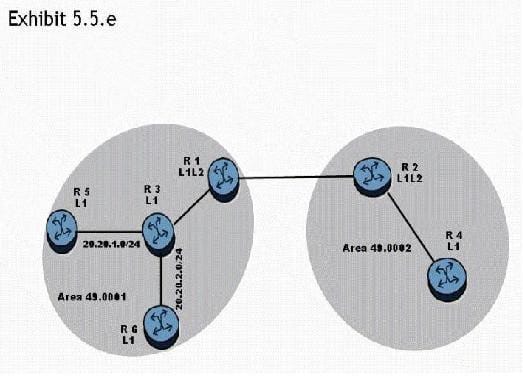Exam Details
Exam Code
:4A0-101Exam Name
:Nokia Interior Routing ProtocolsCertification
:Nokia CertificationsVendor
:NokiaTotal Questions
:315 Q&AsLast Updated
:Mar 30, 2025
Nokia Nokia Certifications 4A0-101 Questions & Answers
-
Question 271:
Which of the following are similarities between OSPF and IS-IS? Choose two answers.
A. Metric is based on hop count.
B. Slow convergence after link failures.
C. Support hierarchy through the use of areas.
D. Support for CIDR.
E. Link state updates sent using layer 3 multicast.
-
Question 272:
Click the exhibit button.

For the IS-IS network shown, and assuming point-to-point links, what adjacencies will router R1 establish?
A. L1/L2 adjacency with router R2. L1 adjacency with router R3
B. L2 adjacency with router R2 L1 adjacency with router R3
C. L1/L2 adjacency with router R2 L1/L2 adjacency with router R3
D. L1/L2 adjacency with router R2. L1 adjacency with router R4 L1 adjacency with router R3
-
Question 273:
What value should the AFI be set to for locally administered addressing?
A. 1
B. 49
C. 47
D. 45
E. 39
-
Question 274:
Click the exhibit button.

In the IS-IS network shown, router R1 has been configured to summarize network 20.20.1.0/24 and 20.20.2.0/24 as 20.20.0.0/16. Which router's routing table will be reduced compared to the routing table before the summarization?
A. Router R1
B. Router R2
C. Routers R1 and R2
D. Router R4
-
Question 275:
Which of the following statements regarding the IS-IS CSNP is false?
A. CSNPs are used to maintain consistency in the link state database.
B. CSNPs are advertised before an adjacency is formed with another router.
C. There are two types of CSNPs: Level 1 and Level 2.
D. CSNPs are advertised after an adjacency is formed with another router.
-
Question 276:
Which of the following statements regarding IS-IS LSPs is true?
A. There are three types of LSPs: L1, L2 and L1/L2.
B. An LSP packet contains the ATT bits and the IS-type bits.
C. The lower the LSP sequence number, the more current the update.
D. Separate databases are maintained for L1 ,, L2, and L1/L2 LSPs.
-
Question 277:
Which of the following is an optional parameter when configuring IS-IS protocol on a router?
A. Configure IS-IS interfaces
B. Enable IS-IS
C. Configure level capabilities
D. Specify an area address
-
Question 278:
Which of the following features are supported by IS-IS? Choose three answers.
A. PDU authentication.
B. The ability to customize the link cost metric.
C. Use of Bellman-Ford routing algorithm.
D. Classless routing.
E. Updates sent as layer 3 multicast.
-
Question 279:
Which of the following types of networks are supported on an Alcatel-Lucent 7750 SR for OSPF? Choose two answers.
A. Broadcast
B. Non-broadcast multi-access
C. Point-to-point
D. Point-to-multipoint
-
Question 280:
If routers R1 and R2 have a Level 1 and Level 2 IS-IS adjacency, which of the following statements is true? Choose two answers.
A. Routers R1 and R2 are in different areas.
B. Routers R1 and R2 are in the same area.
C. Routers R1 and R2 will send a Level 1 Hello PDU and Level 2 Hello PDU, if the interface type between them is point-to-point.
D. Routers R1 and R2 will send a Level 1 Hello PDU and Level 2 Hello PDU, if the interface type between them is broadcast.
E. Routers R1 and R2 will send a Level 1/2 Hello PDU if the interface type between them is broadcast.
Related Exams:
4A0-100
Nokia IP Networks and Services Fundamentals4A0-101
Nokia Interior Routing Protocols4A0-102
Nokia Border Gateway Protocol for Internet Routing4A0-103
Nokia Multiprotocol Label Switching4A0-104
Nokia Services Architecture4A0-105
Nokia Virtual Private LAN Services4A0-106
Nokia Virtual Private Routed Networks4A0-107
Nokia Quality of Service4A0-108
Nokia Multicast Protocols4A0-109
Alcatel-Lucent Triple Play Services
Tips on How to Prepare for the Exams
Nowadays, the certification exams become more and more important and required by more and more enterprises when applying for a job. But how to prepare for the exam effectively? How to prepare for the exam in a short time with less efforts? How to get a ideal result and how to find the most reliable resources? Here on Vcedump.com, you will find all the answers. Vcedump.com provide not only Nokia exam questions, answers and explanations but also complete assistance on your exam preparation and certification application. If you are confused on your 4A0-101 exam preparations and Nokia certification application, do not hesitate to visit our Vcedump.com to find your solutions here.